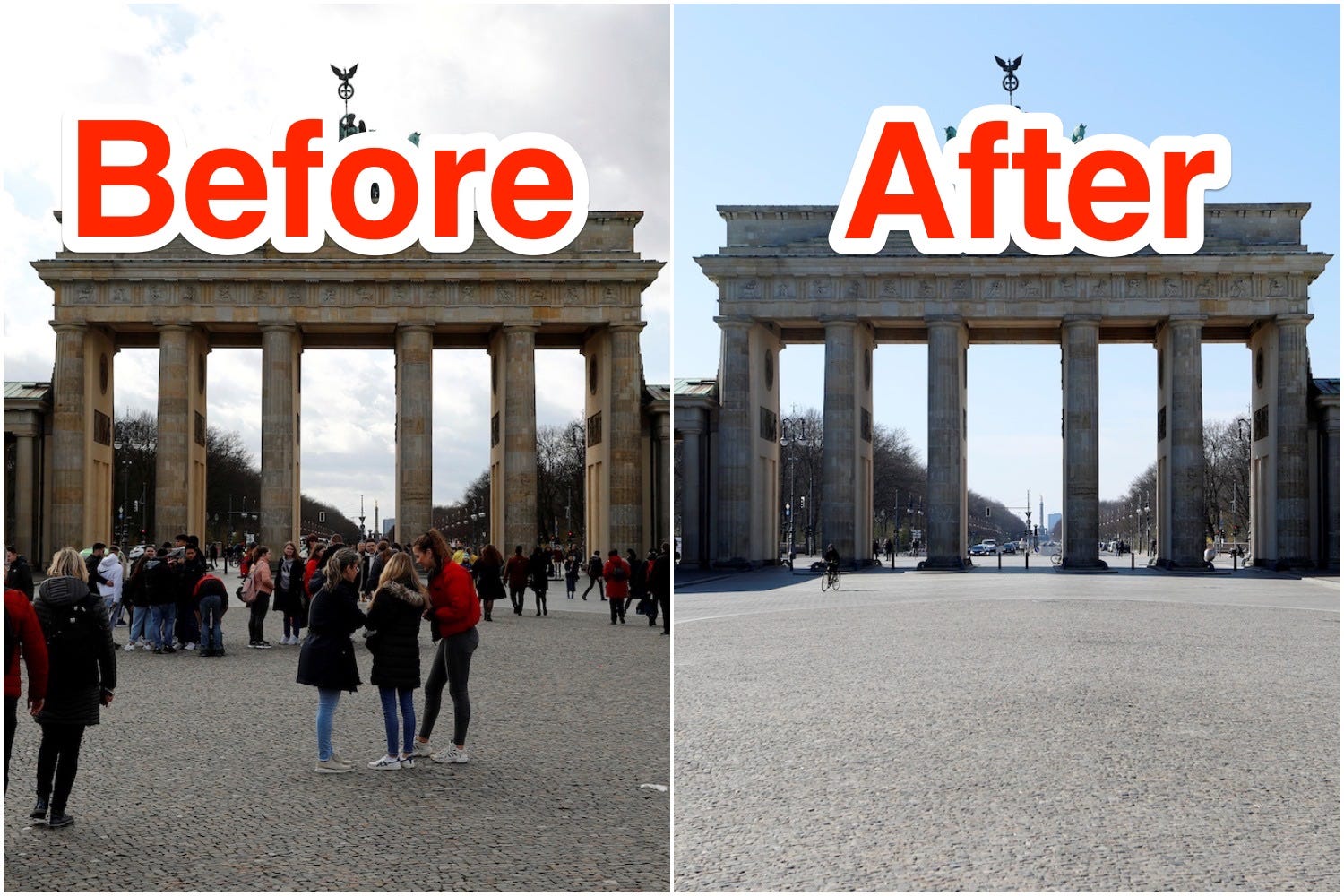- Germany’s capital city, which sees about 13.5 million tourists a year, has seen streets empty out since coronavirus measures were put in place on March 16.
- As a result, Berlin’s historical landmarks and major tourist attractions, including the Brandenburg Gate and Checkpoint Charlie, have been left looking eerily empty.
- Before-and-after photos show famous landmarks in Germany’s capital looking deserted as millions of people stay at home.
- Visit Business Insider’s homepage for more stories.
Germany’s capital Berlin, which has a population of 3.6 million and sees about 13.5 million visitors a year, has been left looking eerily empty amid the coronavirus pandemic.
Even though the country is not under complete lockdown, gatherings of more than two people are banned, and schools, restaurants, shops, and museums were ordered to close starting March 16. These restrictions won’t be lifted until at least April 20.
Germany has more than 63,400 confirmed infections, but it had just 541 deaths as of Monday. The remarkably low death rate – compared with other countries’ – is due largely to mass testing in the country.
Before-and-after photos, some taken only days apart, show how the pandemic has cleared out one of Europe’s busiest cities.
BEFORE: Germany's capital city was still running normally a few weeks ago, before nationwide coronavirus restrictions were put in place. The busy Alexanderplatz U-Bahn station was packed with commuters on March 11.

AFTER: But on March 25, it was close to deserted as most people self-isolated at home.

BEFORE: Above the U-Bahn station, people were still walking through Alexanderplatz, the largest public square in Berlin.

AFTER: Fourteen days later, the same spot looked eerily empty.

BEFORE: Potsdamer Platz is Berlin's largest traffic intersection. This picture from 2019 shows a busy rush-hour scene with bikers and pedestrians.

AFTER: The crossing is now hardly recognizable as the busy traffic has disappeared.

BEFORE: People can be seen waiting at a bus stop on the Kurfürstendamm, Berlin's best-known shopping street, several days before nonessential shops were ordered to close.

The busy shopping street is often referred to as Berlin's version of the Champs-Élysées in Paris.
Source: Visit Berlin
AFTER: Hardly anyone is waiting at that bus stop now.

BEFORE: Berlin's most famous landmark, the Brandenburg Gate, is usually a very popular meeting point for locals and tourists alike.

AFTER: The site, which has been used for many national events including political rallies and large concerts, is now deserted.

BEFORE: This photo, taken in spring 2018, shows people enjoying drinks and food near the Brandenburg Gate.

AFTER: But even as warmer weather approaches, restaurants are shut and only a handful of people can be seen seen roaming around the area.

BEFORE: Another major tourist attraction and historical site, the East Side Gallery —seen here in November 2017 — is usually packed with tourists.

It normally sees crowds of people looking at the graffiti on sections of the Berlin Wall.

AFTER: The gallery is now empty.


BEFORE: Checkpoint Charlie, the best-known former crossing point between East Berlin and West Berlin, attracts about 850,000 visitors a year.

Source: Berlin Museum
AFTER: Nobody is going there now. Germany's restaurants, hotels, and other businesses are now seriously concerned. The government has pledged a massive emergency fund to save hard-hit businesses.

The government expects to run up an extra 156 billion euros, or $169 billion, in debt from the fund, Deutsche Welle reported.
Companies that were in a good position by the end of 2019 are now able to apply for as much as 1 billion euros in emergency aid, the Financial Times reported.
